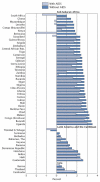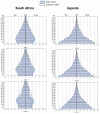The environmental and social influences of HIV/AIDS in sub-Saharan Africa: a focus on rural communities
- PMID: 21845169
- PMCID: PMC3155340
- DOI: 10.3390/ijerph8072967
The environmental and social influences of HIV/AIDS in sub-Saharan Africa: a focus on rural communities
Abstract
The Human Immunodeficiency Virus/Acquired Immunodeficiency Syndrome (HIV/AIDS) pandemic has caused far-reaching effects in sub-Saharan Africa. The pandemic has effectively diminished the workforce, increased poverty rates, reduced agricultural productivity, and transformed the structure of many rural households. HIV/AIDS further strains the already fragile relationship between livelihood and the natural and social environments of these regions. Therefore, the objective of this review is to characterize the impact of HIV/AIDS on the environment and the social infrastructure of rural sub-Saharan Africa. There are many aspects of rural life that contribute to disease transmission of HIV/AIDS and that pose unique challenges to the population dynamics in sub-Saharan Africa. Widespread AIDS-related mortality has caused a decrease in population growth for many African countries. In turn, these alterations in population dynamics have resulted in a decrease in the percentage of prime-age working adults, as well as a gender disparity, whereby, females carry a growing burden of household responsibilities. There is a rising proportion of older adults, often females, who assume the role of provider and caretaker for other dependent family members. These changing dynamics have caused many to exploit their natural surroundings, adopting less sustainable land use practices and utilizing protected resources as a primary means of generating revenue.
Keywords: HIV/AIDS; environment; rural; sub-Saharan Africa.
Figures
Similar articles
-
Women and AIDS in Zimbabwe: the making of an epidemic.Int J Health Serv. 1991;21(1):143-56. doi: 10.2190/N0NJ-FKXB-CT25-PA09. Int J Health Serv. 1991. PMID: 2004868
-
AIDS, population growth shape sub-Saharan Africa's future.Popul Today. 1998 Jan;26(1):1-2. Popul Today. 1998. PMID: 12348208
-
[Community organizations and fighting STDs, HIV and AIDS in Montreal: lessons for sub-Saharan Africa].Sante. 2010 Apr-Jun;20(2):116-24. doi: 10.1684/san.2010.0185. Epub 2010 Aug 5. Sante. 2010. PMID: 20685643 French.
-
The influence of different sexual-contact patterns between age classes on the predicted demographic impact of AIDS in developing countries.Ann N Y Acad Sci. 1989;569:240-74. doi: 10.1111/j.1749-6632.1989.tb27374.x. Ann N Y Acad Sci. 1989. PMID: 2698092 Review.
-
AIDS in sub-Saharan Africa: the epidemiology of heterosexual transmission and the prospects for prevention.Epidemiology. 1993 Jan;4(1):63-72. Epidemiology. 1993. PMID: 8420583 Review.
Cited by
-
Mental health problems in pregnant and postpartum women living with HIV in sub-Saharan Africa: Systematic review and meta-analysis protocol.PLoS One. 2024 Oct 3;19(10):e0308810. doi: 10.1371/journal.pone.0308810. eCollection 2024. PLoS One. 2024. PMID: 39361676 Free PMC article.
-
Exploring Sustainability in the Era of Differentiated HIV Service Delivery in Sub-Saharan Africa: A Systematic Review.J Acquir Immune Defic Syndr. 2021 Aug 1;87(4):1055-1071. doi: 10.1097/QAI.0000000000002688. J Acquir Immune Defic Syndr. 2021. PMID: 33770063 Free PMC article.
-
HIV and Schistosoma haematobium prevalences correlate in sub-Saharan Africa.Trop Med Int Health. 2013 Oct;18(10):1174-1179. doi: 10.1111/tmi.12165. Epub 2013 Aug 18. Trop Med Int Health. 2013. PMID: 23952297 Free PMC article.
-
Social support, mental health needs, and HIV risk behaviors: a gender-specific, correlation study.BMC Public Health. 2019 May 28;19(1):651. doi: 10.1186/s12889-019-6985-9. BMC Public Health. 2019. PMID: 31138239 Free PMC article.
-
A Study on the Knowledge, Attitudes, and Behaviors of Pregnant Women Regarding HIV and Routine Rapid Testing: An Assessment in a High-Risk Marginal Area.Healthcare (Basel). 2021 Jun 24;9(7):793. doi: 10.3390/healthcare9070793. Healthcare (Basel). 2021. PMID: 34202708 Free PMC article.
References
-
- Joint United Nations Programme on HIV/AIDS (UNAIDS) and the World Health Organization (WHO) 2009 AIDS Epidemic Update. UNAIDS; Geneva, Switzerland: 2009. [accessed on 27 October 2010]. Available online: http://data.unaids.org/pub/Report/2009/JC1700_Epi_Update_2009_en.pdf.
-
- Katabira ET, Oelrichs RB. Scaling up antiretroviral treatment in resource-limited settings: Successes and challenges. AIDS. 2007;21:S5–10. - PubMed
-
- El-Sadr WM, Abrams EJ. Scale-up of HIV care and treatment: Can it transform healthcare services in resource-limited settings? AIDS. 2007;21:S65–70. - PubMed
-
- Niehof A, Rugalema G, Gillespie S, editors. AIDS and Rural Livelihoods: Dynamics and Diversity in Sub-Saharan Africa. Earthscan; London, UK: 2010.
-
- Dorward AR, Mwale I, Tuseo R. Labor market and wage impacts of HIV/AIDS in Rural Malawi. Appl. Econ. Perspect. Pol. 2006;28:429–439.
Publication types
MeSH terms
Grants and funding
LinkOut - more resources
Full Text Sources
Medical



